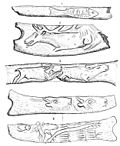Prehistory
Prehistory refers to the period of time before written records. The concept of prehistory is a modern one, and it is used to describe the long period of time before the development of writing systems, which marked the beginning of recorded history. Prehistory is divided into three ages: the Stone Age, the Bronze Age, and the Iron Age.
Stone Age[edit]
The Stone Age is the earliest period of prehistory, during which humans used tools and weapons made of stone. This period is further divided into the Paleolithic, Mesolithic, and Neolithic periods.
Paleolithic[edit]
The Paleolithic period, also known as the Old Stone Age, is characterized by the use of simple stone tools. This period is further divided into the Lower, Middle, and Upper Paleolithic.
Mesolithic[edit]
The Mesolithic period, also known as the Middle Stone Age, is characterized by the development of more advanced stone tools and the beginnings of settled communities.
Neolithic[edit]
The Neolithic period, also known as the New Stone Age, is characterized by the development of agriculture and the establishment of permanent settlements.
Bronze Age[edit]
The Bronze Age is characterized by the use of bronze tools and weapons, and the development of early writing systems.
Iron Age[edit]
The Iron Age is characterized by the use of iron and steel tools and weapons, and the development of more advanced writing systems.
See also[edit]
References[edit]
<references />
|
|
|
-
Delineations on pieces of antler
-
Loewenmensch
-
Flute made from swan bone, Geissenklösterle, Blaubeuren
-
Göbekli Tepe, Urfa
-
Prehistoric man
-
Spreading of Homo sapiens
-
Dugout boats, Kierikki Centre, Oulu
-
Hagar Qim, Malta
-
Neolithic artifacts
-
Luni sul Mignone monumental building
-
Los Millares recreation
-
Timna Chalcolithic Mine
Ad. Transform your life with W8MD's Budget GLP-1 injections from $75


W8MD offers a medical weight loss program to lose weight in Philadelphia. Our physician-supervised medical weight loss provides:
- Weight loss injections in NYC (generic and brand names):
- Zepbound / Mounjaro, Wegovy / Ozempic, Saxenda
- Most insurances accepted or discounted self-pay rates. We will obtain insurance prior authorizations if needed.
- Generic GLP1 weight loss injections from $75 for the starting dose.
- Also offer prescription weight loss medications including Phentermine, Qsymia, Diethylpropion, Contrave etc.
NYC weight loss doctor appointmentsNYC weight loss doctor appointments
Start your NYC weight loss journey today at our NYC medical weight loss and Philadelphia medical weight loss clinics.
- Call 718-946-5500 to lose weight in NYC or for medical weight loss in Philadelphia 215-676-2334.
- Tags:NYC medical weight loss, Philadelphia lose weight Zepbound NYC, Budget GLP1 weight loss injections, Wegovy Philadelphia, Wegovy NYC, Philadelphia medical weight loss, Brookly weight loss and Wegovy NYC
|
WikiMD's Wellness Encyclopedia |
| Let Food Be Thy Medicine Medicine Thy Food - Hippocrates |
Medical Disclaimer: WikiMD is not a substitute for professional medical advice. The information on WikiMD is provided as an information resource only, may be incorrect, outdated or misleading, and is not to be used or relied on for any diagnostic or treatment purposes. Please consult your health care provider before making any healthcare decisions or for guidance about a specific medical condition. WikiMD expressly disclaims responsibility, and shall have no liability, for any damages, loss, injury, or liability whatsoever suffered as a result of your reliance on the information contained in this site. By visiting this site you agree to the foregoing terms and conditions, which may from time to time be changed or supplemented by WikiMD. If you do not agree to the foregoing terms and conditions, you should not enter or use this site. See full disclaimer.
Credits:Most images are courtesy of Wikimedia commons, and templates, categories Wikipedia, licensed under CC BY SA or similar.
Translate this page: - East Asian
中文,
日本,
한국어,
South Asian
हिन्दी,
தமிழ்,
తెలుగు,
Urdu,
ಕನ್ನಡ,
Southeast Asian
Indonesian,
Vietnamese,
Thai,
မြန်မာဘာသာ,
বাংলা
European
español,
Deutsch,
français,
Greek,
português do Brasil,
polski,
română,
русский,
Nederlands,
norsk,
svenska,
suomi,
Italian
Middle Eastern & African
عربى,
Turkish,
Persian,
Hebrew,
Afrikaans,
isiZulu,
Kiswahili,
Other
Bulgarian,
Hungarian,
Czech,
Swedish,
മലയാളം,
मराठी,
ਪੰਜਾਬੀ,
ગુજરાતી,
Portuguese,
Ukrainian















